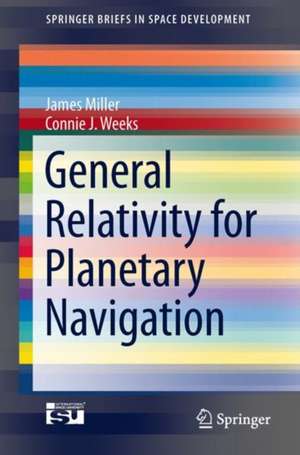General Relativity for Planetary Navigation: SpringerBriefs in Space Development
Autor James Miller, Connie J. Weeksen Limba Engleză Paperback – sep 2021
The software used for planetary missions is derived from mathematics that use matrix notation. An alternative is to use Einstein summation notation, which enables the mathematics to be presented in a compact form but makes the geometry difficult to understand. In this book, the relationship of matrix notation to summation notation is shown. The purpose is to enable the reader to derive the mathematics used in the software in either matrix notation or summation notation.
This brief is a useful tool for advanced students andyoung professionals embarking on careers in planetary navigation.
Din seria SpringerBriefs in Space Development
-
 Preț: 262.68 lei
Preț: 262.68 lei -
 Preț: 379.09 lei
Preț: 379.09 lei -
 Preț: 378.12 lei
Preț: 378.12 lei -
 Preț: 379.09 lei
Preț: 379.09 lei -
 Preț: 380.07 lei
Preț: 380.07 lei -
 Preț: 477.72 lei
Preț: 477.72 lei -
 Preț: 474.84 lei
Preț: 474.84 lei - 15%
 Preț: 463.35 lei
Preț: 463.35 lei -
 Preț: 376.96 lei
Preț: 376.96 lei -
 Preț: 410.77 lei
Preț: 410.77 lei - 15%
 Preț: 463.35 lei
Preț: 463.35 lei -
 Preț: 410.39 lei
Preț: 410.39 lei - 15%
 Preț: 461.87 lei
Preț: 461.87 lei -
 Preț: 380.45 lei
Preț: 380.45 lei -
 Preț: 378.34 lei
Preț: 378.34 lei -
 Preț: 378.34 lei
Preț: 378.34 lei -
 Preț: 377.35 lei
Preț: 377.35 lei - 5%
 Preț: 358.48 lei
Preț: 358.48 lei -
 Preț: 443.58 lei
Preț: 443.58 lei -
 Preț: 378.12 lei
Preț: 378.12 lei -
 Preț: 425.27 lei
Preț: 425.27 lei -
 Preț: 317.73 lei
Preț: 317.73 lei -
 Preț: 444.74 lei
Preț: 444.74 lei -
 Preț: 344.53 lei
Preț: 344.53 lei -
 Preț: 378.12 lei
Preț: 378.12 lei
Preț: 477.17 lei
Nou
Puncte Express: 716
Preț estimativ în valută:
91.32€ • 94.99$ • 75.39£
91.32€ • 94.99$ • 75.39£
Carte tipărită la comandă
Livrare economică 14-28 aprilie
Preluare comenzi: 021 569.72.76
Specificații
ISBN-13: 9783030775452
ISBN-10: 3030775453
Pagini: 104
Ilustrații: VI, 104 p. 18 illus., 1 illus. in color.
Dimensiuni: 155 x 235 mm
Greutate: 0.17 kg
Ediția:1st ed. 2021
Editura: Springer International Publishing
Colecția Springer
Seria SpringerBriefs in Space Development
Locul publicării:Cham, Switzerland
ISBN-10: 3030775453
Pagini: 104
Ilustrații: VI, 104 p. 18 illus., 1 illus. in color.
Dimensiuni: 155 x 235 mm
Greutate: 0.17 kg
Ediția:1st ed. 2021
Editura: Springer International Publishing
Colecția Springer
Seria SpringerBriefs in Space Development
Locul publicării:Cham, Switzerland
Cuprins
Chapter 1: Einstein Field Equations.- Chapter 2: Schwarzschild Solution for Metric Tensor.- Chapter 3: Comparison of Numerical Integration and Analytic Solutions.- Chapter 4: General Relativity Time Delay Experiment Experimental Results.
Notă biografică
James Miller worked as the assistant Navigation Team Chief on the Viking Mission to Mars in 1976. In 2000, he received the Mechanics and Control of Flight medal from the AIAA for his design of the navigation system for the first orbiting and landing on the asteroid Eros. Further, he designed a trajectory to leave Earth and orbit the Moon with no propulsive maneuvers. This was the first practical solution of the four-body problem, and it has since been used on the missions Hiten, Genesis, and Grail.
Textul de pe ultima copertă
This brief approaches General Relativity from a planetary navigation perspective, delving into the unconventional mathematical methods required to produce computer software for space missions. It provides a derivation of the Einstein field equations and describes experiments performed on the Near Earth Asteroid Rendezvous mission, spanning General Relativity Theory from the fundamental assumptions to experimental verification.
The software used for planetary missions is derived from mathematics that use matrix notation. An alternative is to use Einstein summation notation, which enables the mathematics to be presented in a compact form but makes the geometry difficult to understand. In this book, the relationship of matrix notation to summation notation is shown. The purpose is to enable the reader to derive the mathematics used in the software in either matrix notation or summation notation.
The software used for planetary missions is derived from mathematics that use matrix notation. An alternative is to use Einstein summation notation, which enables the mathematics to be presented in a compact form but makes the geometry difficult to understand. In this book, the relationship of matrix notation to summation notation is shown. The purpose is to enable the reader to derive the mathematics used in the software in either matrix notation or summation notation.
This brief is a useful tool for advanced students and young professionals embarking on careers in planetary navigation.
Caracteristici
Explores General Relativity from a space navigation perspective Provides a linear progression from theory to experimental results in planetary spacecraft navigation Includes detailed explanations of mathematical operations involved in spaceflight, starting from first principles
